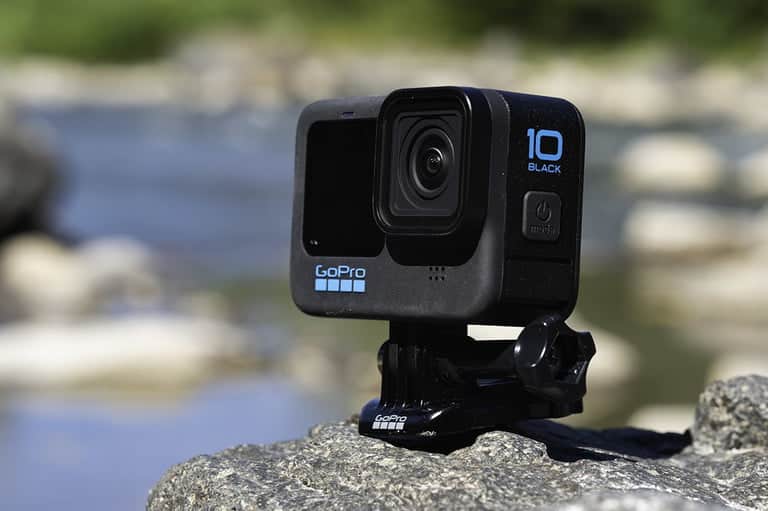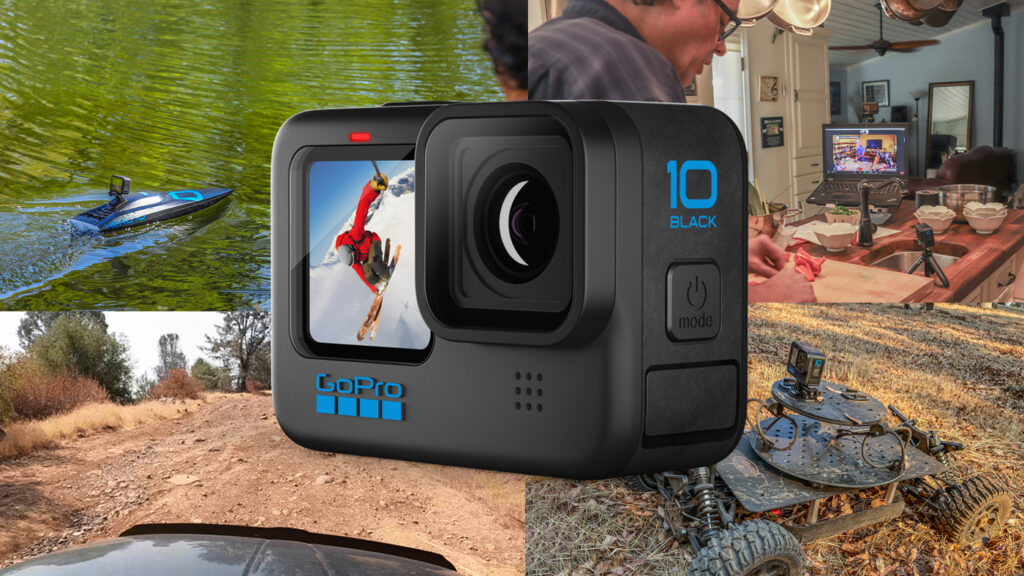Distance Converter
Acameramen is going to examine the GoPro Hero10 Black in more detail in our evaluation of this company’s most recent action camera. A brand-new, more potent GP2 chipset takes center stage with the HERO 10, which is essentially an evolutionary upgrade to 2020’s well-received HERO 9. Performance has also been increased in several other areas, most notably by doubling the framerate. The physical dimensions and design are nearly identical to those of the HERO 9 Black, and the battery capacity is unchanged.
The top model in GoPro’s current lineup of three HEROs is the HERO 10. Visit our reviews of the GoPro HERO 9 Black and GoPro HERO 8 Black for a deeper look at the other two, or check out how all the different models stack up in our list of the top GoPros currently on the market.
So does this new product win the title of best action camera? Continue reading for a detailed evaluation of the GoPro Hero10 Black, its features, price, and an explanation of all the major improvements.
GoPro Hero10 Black Review
GoPro Hero10 Black: Design

The great news for GoPro fans is that the new GoPro Hero10 Black looks like the groundbreaking GoPro HERO 9 Black; The only difference that’s immediately noticeable is that the GoPro logo under the front display is now stylish blue, as is the side caption that reads “10 Black”. When you compare the two, you’ll find that the body of the GoPro HERO 10 Black is a bit darker – more true black than graphite – than its predecessor.
The battery compartment, USB-C charging port, 1720mAh Lithium battery, and battery cover may be shared with the HERO 9 Black elsewhere. The batteries are definitely interchangeable between two, and the charging times are about the same (taking into account the variation between new and old batteries). It’s great that the “finger” flips down to mount the camera is the same as on the HERO 9 Black and is backward compatible with many GoPro mounts from previous generations.
The HERO 9 Black’s operating buttons — a side-by-side mode and top-mounted power and record buttons — are similar. Both are rubber-coated and glove compatible due to their generously sized surfaces. There is, however, one significant external change: while the HERO 10 Black’s removable main lens cap looks similar to the HERO 9 Black’s, it functions completely differently.
According to GoPro, the GoPro Hero10 Black lens cap has more waterproof, scratch-resistant glass with less ghosting. In tests, this was especially evident. The water droplets rise and flow instead of spreading, and the nodules can be removed simply with another finger. Finally, it is unacceptable to lick the lens, which is fortunate in many cases of poor hygiene.
GoPro Hero10 Black: Features
Even while the LCD panels are exactly the same size as those of the HERO 9 Black, there is good news for usability: the back screen has significantly increased touch sensitivity built in, which is instantly noticeable when navigating the menus. It is irrelevant whether or not the better touchscreen is to blame for this; it is noticeably smoother than the previous generation’s touchscreen.
In fact, the GP2 chipset is the main factor in the HERO 10’s overall improvement. It provides both direct benefits, such as faster boot and transfer times, and support for the new HyperSmooth 4.0 and indirect ones, such as improved picture and video quality.
A brand-new cable data transmission option for phones is really useful, especially when used with the updated Quik software, and as a bonus, the HERO10 black sends video to the cloud while it’s charging. GoPro claims that this mode is 50% quicker than wireless. but, only if you have a GoPro subscription.
GoPro Hero10 Black: Performance

While the GP2 processor in the Hero 10 Black does make it a more well-rounded, enjoyable camera to operate than its predecessor, several parts of its performance are still standard GoPro.
Sadly, battery life and overheating are two of them. The Hero 9 Black’s 1,720mAh battery, which powers the GoPro Hero10 Black, is bigger than the batteries in any prior GoPro models. But the Hero 10 Black’s more demanding dual displays and high frame-rate settings use a significant portion of its space.
We were able to achieve 72 minutes of recording from the Hero 10 during our battery test, which involved the camera shutting down twice due to overheating while recording a continuous 4K/30p clip with HyperSmooth on and the screen brightness set to 50%.
It’s evident that the famous GoPro proverb—make sure you have a spare battery or two with you—is accurate because this is really a touch less than we obtained with the Hero 9 Black and comparable to the outcome for the Hero 8 Black. Our fully charged GoPro Hero10 Black offered us three and a half hours in a real-world test when we were visiting an adventure park before it shut down. Although the camera had a demanding afternoon of frequent menu swiping and frame-rate switching, this is also a regular day for a GoPro.
However, the new slow-mo settings for the GoPro Hero10 Black (4K/120p and 2.7K/240p) are a lot of fun and a wonderful way to spice up your social media videos. One of the main reasons to upgrade from an older GoPro is the versatility these modes give you, especially when combined with horizon-leveling and HyperSmooth stabilization. When photographing in these modes, there is as usual a perceptible quality loss, especially if you are not in direct sunlight.
Audio is another GoPro flaw that hasn’t changed from the Hero 9 Black. In calmer settings, the microphones do generate passable sound quality, and the previous GoPros really pale in comparison in terms of speech isolation and wind noise management. However, if you want to ensure that the audio quality matches your video, we advise acquiring the Media Mod attachment and either connecting a lavalier mic or purchasing a wireless alternative like the Rode Wireless Go II.
GoPro Hero10 Black: Video And Image Quality

The GoPro Hero10 Black’s default video settings have seen various tweaks from GoPro. The manufacturer of action cameras has suddenly outgrown the distinctive saturated aesthetic it formerly favored, opting instead for a more natural design right out of the box.
Actually, there are now three other color selections available. Previously, you could choose between a “GoPro” color profile, which created vibrant, punchy colors, and a “flat” color profile, which you could then grade. However, there is now a second profile called “Natural” that is the new default, and we really like it.
GoPro has also set the “sharpness” at medium by default, which is a smart decision. However, for the best image quality, we usually shoot with the sharpness on “low” and the bit rate at “high” (or 100Mbps). The results were similar to footage taken with the same settings on the Hero 9 Black, although with slight enhancements that are probably attributable to the improved local tone mapping.
However, the Hero 9 Black has previously outperformed prior GoPros in terms of quality thanks to its upgraded sensor, so unless you’re a serious pixel peeper, you probably won’t notice a significant change here. The new slow-mo settings are the most entertaining, while the 5K/60p mode is good to have even if it’s not ideal for action sequences due to the less robust stabilization.
The GoPro Hero10 Black’s slower frame rates of 120p and 240p (especially the latter) obviously still have a softness to the footage, but the ability to record in 4K/120p and 2.7K/240p elevates them from novelty to something that is actually useful. The improvements to horizon leveling are a wonderful addition, and GoPro’s HyperSmooth continues to be the best action camera smoothing option available.
On the other hand, not many people purchase a GoPro to capture still images, and although the GoPro Hero10 Black is a serviceable, waterproof substitute for your smartphone, it has lagged behind rivals in this area.
The images are rather clear and vivid in excellent lighting, and SuperPhoto can help you recover some highlight elements from places like the sky. However, the Hero 9 Black’s 3MP resolution upgrade won’t be perceptible to most people, and in challenging settings – especially low light – it can’t match with the processing capabilities of Apple, Google, and Samsung.
Although shooting in raw is a possibility, it can only be done with the ‘wide’ fisheye view, and a 1/2.3-inch sensor has a limited ability to recover shadow detail.
Accepting the sub-smartphone quality and embracing the simplicity of “frame grabs,” which now allow you to get somewhat enhanced 15.8MP stills from 5.3K video, maybe the most practical approach to GoPro photography (or 19.6MP from 5K 4:3 footage). The GoPro’s ability to wander into hazardous terrain remains one of the key reasons to get one. The kinds of pictures you get from doing this are unlikely to be found on your phone’s camera roll.
Conclusion
The key question in our GoPro HERO 10 Black review is: Is it worth buying? Apple’s equivalent action camera has done it again, improving the product just enough to get noticed but not enough to affect sales of the former, now somewhat cheaper model. While we’ve given the HERO 9 Black five stars and it’s still an excellent camera, there are a few areas where the HERO 10 Black excels.
